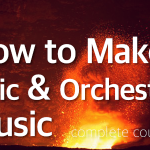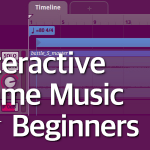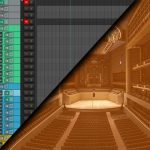You don’t need a home studio to make music. This is something beginners often struggle with and in result, they buy a lot of things they do not need, while they should be focusing on actually learning how to produce music. At some point, though, you will start to think about setting up your studio. How to do this? Short answer: one thing at the time. There’s no need to buy everything at once. Where should you start? How should you proceed? What gear do you actually need? Let’s answer these questions.
Before we proceed, here are my assumptions:
- You want a way to start – you need the basics. What kind of gear you absolutely need and at which point in time?
- You don’t want to spend too much money. You have limited budget and you’re still unsure if you want to stick to this new hobby.
- You don’t really know what you’re doing. None of as knew when we were beginners.
Thus, I will give you only a single gear example for each “category”, and it will be affordable. With this kind of gear, you can start and improve your music, but surely later on you will want to grab even more advanced gear. I will cover this in another article.
Tips for a Good Start
Let’s start with a couple of tips.
- Don’t spend too much money when you’re just starting out. You don’t need too many things to make music, and the things you do have don’t have to be the best on the market. The simplest example is this: for the first few months, or even a year, you will be learning how to compose and how to orchestrate your music. At this time you may already start learning how to mix orchestral music, but you may not have too many great pieces to mix. There’s no need to treat your room, buy an audio interface and studio monitors for first couple of months.
- Always check product reviews. This should be obvious. But even product reviews can be tricky. For example, there are many reviews of basic and cheapest Mackie studio monitors, but a lot of people say they can easily get broken. This persuaded me to spend more money and grab JBL monitors with better reviews. At the same time, many people say their Mackie work perfectly and “getting broken” is often a result of improper use by the owner. Thus, unfortunately, in the end you have to make the final decision.
- Expensive doesn’t mean better – you really can get great gear and hardware that is also affordable. At the same time, expensive doesn’t mean stuff won’t break. An in many ways, expensive gear often has many features and can do a lot of things you won’t really need at first. And you may never use them.
- If you don’t know something, learn. This is exactly what you’re doing right now. The Internet is full of useful articles and tutorials, reviews and helpful discussion boards, where you can find the answers. This is actually how I figured out the type of cables I needed for my studio monitors :).
I always say, “start small” and build from there. The same goes for software for music production. In my course, how to make epic orchestral music, I recommend you buy only a single, all-in-one orchestral library such as Symphobia, Albion One or Metropolis Ark 1, which are great for beginners interested in orchestral music.
Headphones for Home Studio
Let’s assume that you won’t be recording any live instruments. But even when you compose with virtual instruments, at some point you will have to mix your music. You can learn a lot about mixing music without any headphones or computer speakers, so don’t rush things. But as soon as you decide you want to improve your mixes, you need some speakers or headphones that have a better quality of sound.
Which one to choose? The idea is quite simple: purchase open or semi-open headphones first. Why not studio speakers (studio monitors)? Because studio monitors require you to have a room that is prepared for work with audio. Thus, you need sound treatment such as bass traps or acoustic panels. At first, you want to lower your costs and you don’t want to buy any bass traps and such. Thus, headphones are a better choice.
There are many brands on the market, but I will keep things simple and recommend only one product: AKG K240. They’re affordable, they cost about $70 and they’re good enough to start with.
- Grab AKG K240 on Amazon (aff)
Open and semi-open headphones are great for mixing music (at the same time, close headphones are a better choice for recording). And whenever you shop for headphones or speakers for mixing, you want a product with as flat sound as possible. Flat in this case means that the sound the headphones/speakers produce is equal throughout the frequency spectrum. Neither the bass, nor the midi or the highs is boosted. Boosted frequencies are not recommended when you want to use your gear for mixing.
With new headphones you will be able to improve your mixes.
MIDI Keyboard
The next thing you may want to buy is a MIDI keyboard. Actually, this will be the first thing you get if you already know how to play a piano. If you do, getting a MIDI keyboard is a natural thing and there’s nothing more to say. But if you don’t know how to play a piano, MIDI keyboard will not be your priority.
You may buy it now, or even in the future, but I do suggest that you may find it useful. Having a MIDI keyboard allows you to play melodies and chords before putting them into your DAW’s project. If you can hear your musical ideas, it’s much easier to compose and develop them.
I recommend you get M-Audio Oxygen 61. This is a great MIDI keyboard that will work perfectly fine for years. But, please note – I’m not a professional piano player, and I don’t record my music live. I use the keyboard for melodies and chords, so my recommendation is targeted to people who will use the keyboard the same way I use it.
- Grab M-Audio Oxygen 61 (aff)
If you want to play a lot, record live, and use the keyboard for live performances, Oxygen 61 may be OK, but I’m not sure how well will it work throughout years under “heavier” use.
This keyboard also comes with additional keys and faders that you can connect with MIDI CC and your DAW.
Audio Interface
After some time, when you already know how to compose music, you produced a couple of nice tracks and you want to improve your mixes, you may start by grabbing an audio interface. Audio interface is like a sound card with a lot of additional sockets and connectors. You will need it sooner or later to:
- Connect your headphones that require additional amplifier.
- Connect your studio monitors that won’t have a cable that fits your PC.
- Connect your microphone that isn’t USB-ready.
To start with, I would recommend Behringer U-Control (off) audio interface. It is very affordable, and it allows you to connect stereo input (mic), stereo output (studio monitors) and headphones. It’s a basic setup that works on USB cable to connect with your computer. Once you have an audio interface, you can start thinking about buying studio monitors, but there’s a catch.
Room Treatment
Before you think about recording instruments and mixing with studio monitors, you should think about room treatment. You need to lower the amount of echo in your room, and deal with some unwanted frequencies. We do so by putting a carpet on the floor, and gluing special panels to the walls, corners and the ceiling.
- First, you may want to grab a carpet to place on the floor. This will reduce sound reflections.
- Every corner of the room, that is: wall-to-wall and wall-to-ceiling, should be treated with bass traps (aff). These absorption foams are used to deal with very low frequencies that like to build up in the corners of the room.
- Walls should be covered with absorption panels (aff). Such panels come in various sizes and shapes. Some are flat, some have a lot of pyramids one them :).
The simplest way to do this is as follows: put bass traps in wall-to-wall and wall-to-ceiling corners. Place a small carpet on the floor. And place absorption panels on all the walls and the ceiling. This is the best tactic for beginners. Try to cover at least 1/2 or 3/4 of each wall with foam panels.
If you want to set up a more professional studio, a good idea is to hire a professional sound specialist who will check your room and recommend more professional treatment. Every room is different – it has different shape and size, so each room must be treated individually. Sound waves move in various ways through various rooms, and only an expert can really advise you as to what you really need and where to put it.
You can also place a diffusor (aff)(diffusion panel) on the wall, but again this is a more complex stuff and you should ask an expert.
While some online tutorials suggest you can use blankets on the walls and a lot of pillows, don’t do this. This will work well if you’re recording YouTube videos or online courses, but it won’t be very useful for mixing music. Also, don’t even think about buying egg boxes (egg cartons). They really don’t work :).
Studio Monitors
Once you prepared the room for working with audio, studio monitors are the next thing to buy. Studio monitors are like computer speakers, but they bigger, they require additional power supply and they usually have a flat sound response, and none of the frequency is particularly boosted. Remember that studio monitors will work only in room that is properly treated.
Buying studio monitors may be a bit more complicated, because you also need pads, stands and cables.
I recommend JBL 305
- Grab JBL 305 on Amazon (aff)
Please note that usually you buy a single monitor and you need two of them to achieve a stereo sound. Pay attention when shopping – some shops sell single speakers, and some sell sets made of two speakers.
You also need isolation pads – soft things that you place under the speakers. Such pads are used to limit the amount of vibration passed from the floor to the speakers.
- Isolation pads (aff)
Isolation pads can be placed on a desk and this will work. But they can also be placed on monitor stands that you can place on both sides of your desk, and place the monitors on them.
- Monitor stands (off)
In case of isolation pads and monitor stands, you also have to pay attention – some stores sell sets of 2, and some sell only a single product. Make sure you get a pair of each.
Another thing you need are cables. Some speakers come with cables, some need you to buy cables separately. And you never know what kind of cables you need (believe me, it’s not that easy). You can wait for the speakers to arrive, and then take a look at their sockets. Then, go on the Internet and do some reading, before purchasing. You can also contact the store’s support and ask for help. You will need to know what kind of audio interface you have and what sockets the interface has.
Mic and Other Stuff
I’m not an expert in audio recording, and I’m a fan of things you can use for many things at the same time. Thus, I like to recommend simple mics that you can use for both recording your podcast and YouTube video, as well as to record your instruments. I use SM900 by SPC Gear, it’s a USB mic dedicated for YouTube and streaming, and I only recently got it (I never had the need to record anything before), so beyond these few words, I can’t really say much about it just yet. With time, I will update this article and let you know.
You don’t need any hardware mixer – it’s a good idea to grab one in the future, if you do a lot of mixing, but not when you’re just starting out.
I’d say that it will probably take a year up to three years before you get to the point when you actually need room treatment and studio monitors. A year for more serious people who want to progress faster, and three years for people who just think of music production like a hobby and they do this in their spare time. Less time for people who consider this their new career, and more time for people who still go to school and just want to have fun. Take your time.
Oh, by the way, if you live in Europe, then there is a great online store here, Thomann (not an affiliate link). You can buy instruments, software and studio gear there. When in doubt, ask their customer support for help.
Don't forget to become a fan on Facebook and subscribe to new posts via RSS or via email.











